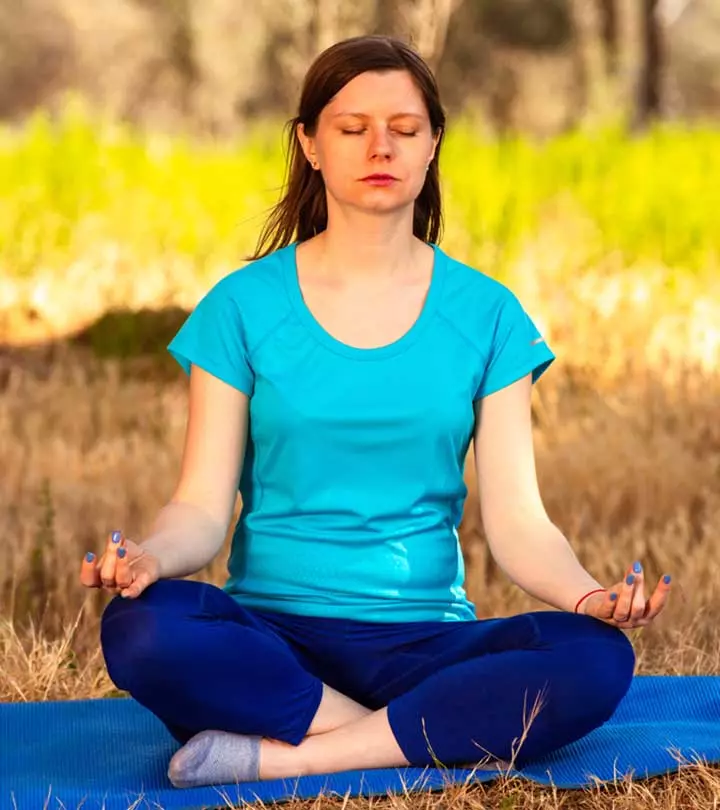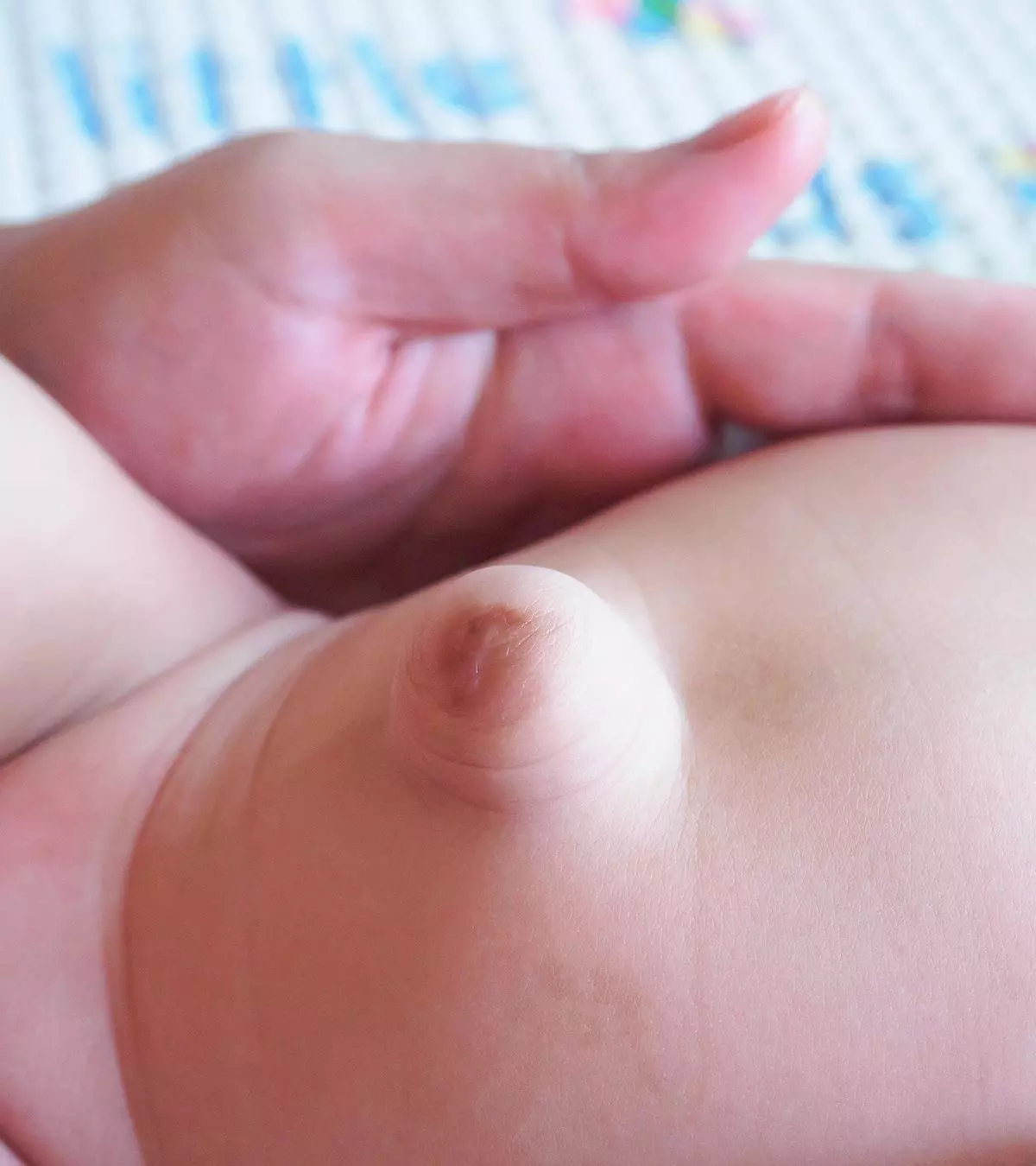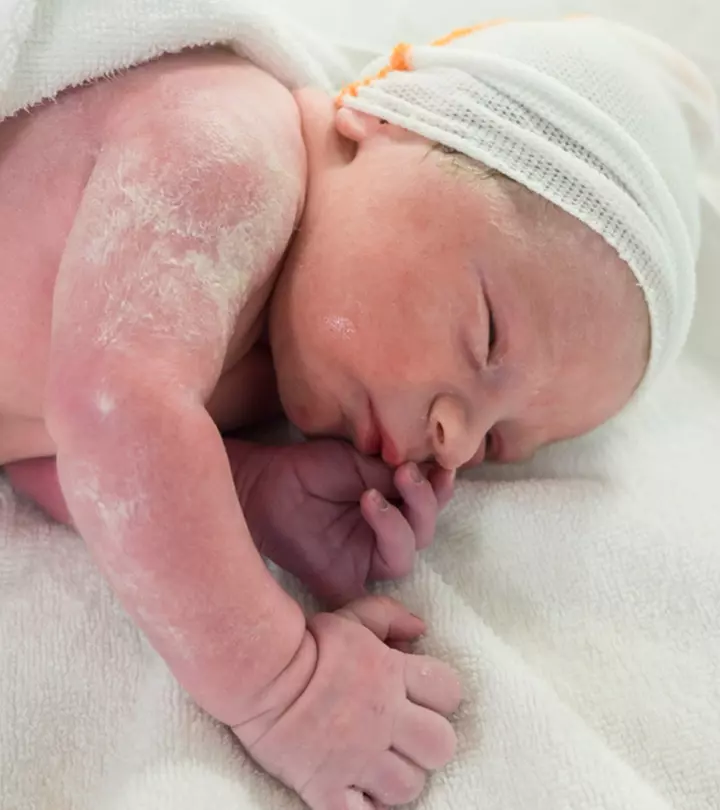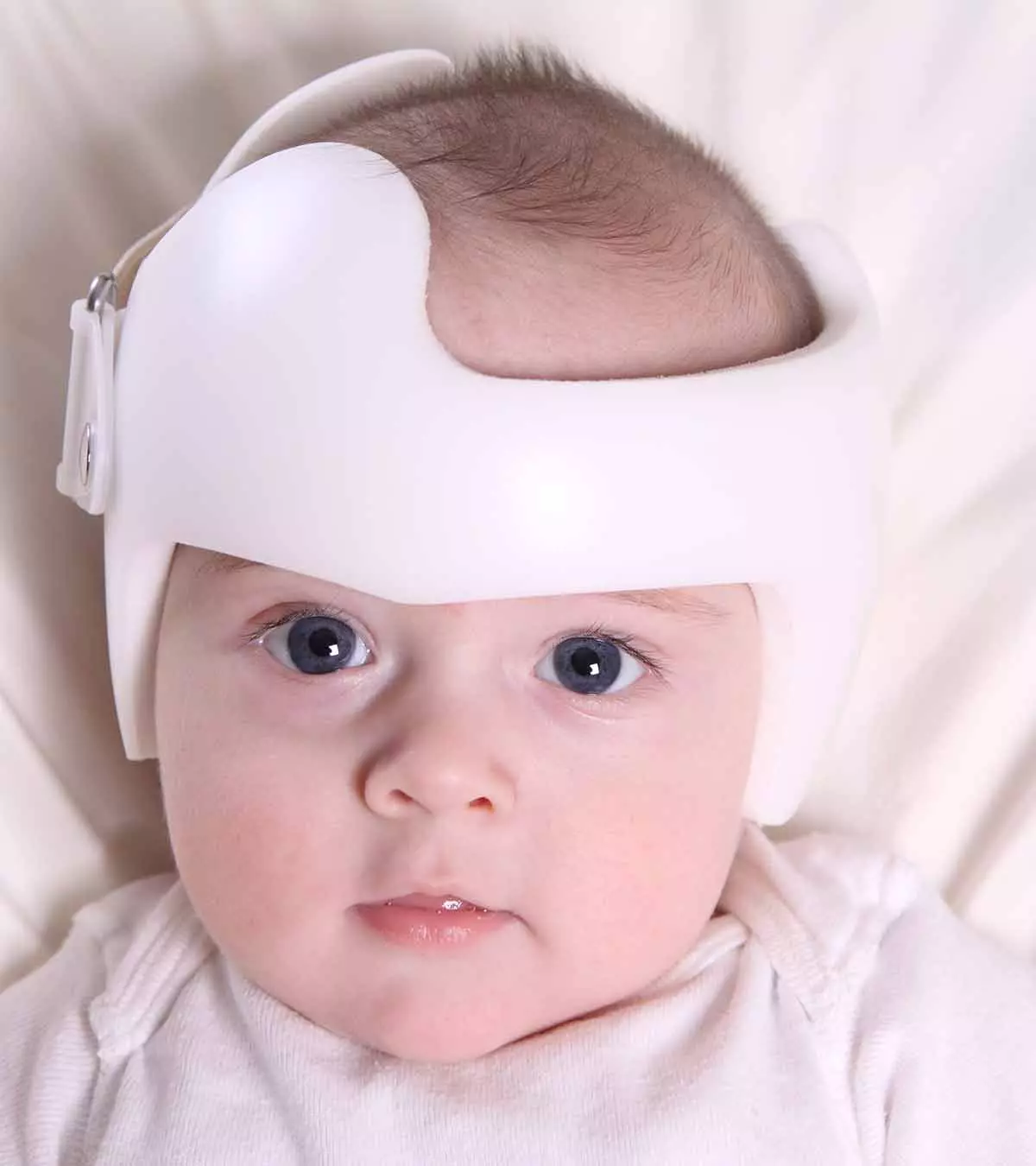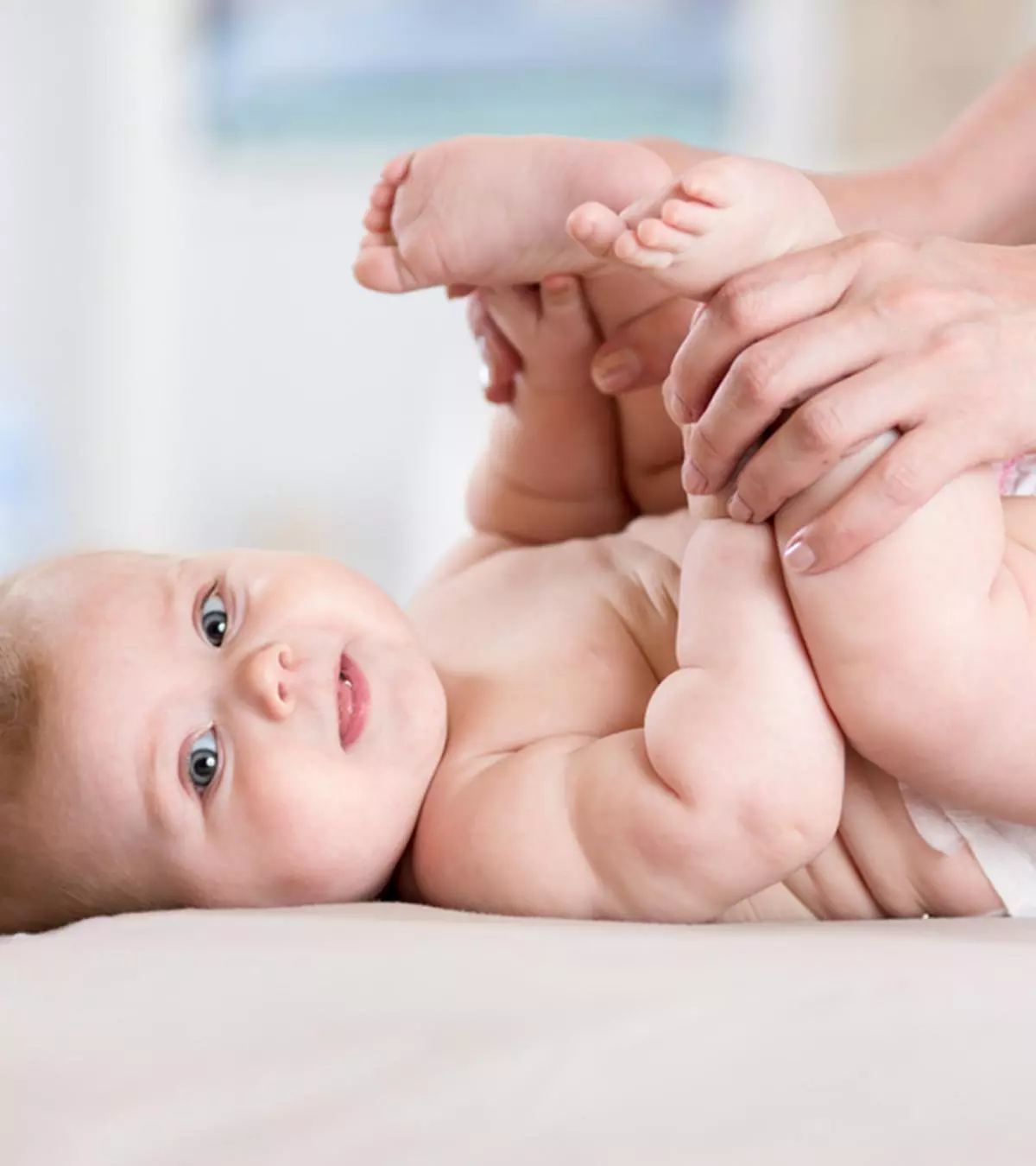
Image: Shutterstock
Babies and toddlers require adequate physical activity, too, just like older children. As the infant grows older, parents might try assistive exercises for babies and teach them these in relevant ways. Physical activity promotes a baby’s overall development and growth. It also makes it easier for children to start living an active lifestyle from a young age. This post discusses the relevance of infant exercises and various exercises for different age groups.

Key Pointers
- Exercise helps babies build stronger bones, develop motor skills, better sleep, improve flexibility, etc.
- You can encourage daily physical activity, provide them with enough space to move, and help them adjust both indoors and outdoors.
- Babies need different exercises based on their age; those between zero and six months need grasping practice, whereas those between six and twelve months may enjoy assistive crunches.
Why Do Infants Need Exercise?
Baby exercises could help your little one try different body movements and explore their surroundings better.
It may also provide them with the following benefits (1) (2) (3).
- Help build stronger bones, muscles, and joints
- Help your baby’s brain make millions of connections through the development of motor skills
- Improve coordination, balance, flexibility, and range of motion
- Improve their sleep quality and time
- Strengthen various organ systems
- Boost their confidence and social skills when exercises are done with peers
- Physical activity in late infancy may help the baby maintain a healthy BMI
Physical development in infants is closely linked to their overall growth, and engaging them in various activities can support this process. Besides the physical benefits, regular exercise may contribute to a baby’s cognitive development (4). When a baby is inactive, activities such as reading or telling stories, singing, or painting could also help in cognitive stimulation (5).
Exercise Guidelines For Babies
The World Health Organization (WHO) has set guidelines for physical activity in children under five. It states, “Infants (less than 1 year) should be physically active several times a day in a variety of ways, particularly through interactive floor-based play; more is better. For those not yet mobile, this includes at least 30 minutes in the prone position (tummy time) spread throughout the day while awake. It is recommended that babies participate in supervised floor-based activities and play from birth to one year (6).”
Here are some guidelines to follow when engaging your baby in exercise (7):
- Encourage some amount of physical activity every day, and ensure they get enough crawling time.
- If your baby does not crawl yet, encourage them to grasp, pull, hold, push, or move their head, hands, and feet.
- Ensure your baby gets at least 30 minutes of tummy time every day while awake.
- Once your baby begins to crawl, give them ample safe space to exercise their skills.
- Allow your baby to hold on to stable objects and pull to stand.
- Encourage your baby to reach out for toys during tummy time.
- Encourage a good balance of indoor and outdoor play to enhance their senses.
- Avoid restraining your baby or keeping them inactive for more than an hour.
- Ensure there is constant interaction with you as it promotes exploration of their environment.
- Place your infant on a rug or blanket of at least five to seven feet in length during playtime. It helps ensure their safety.
- Make sure exercises are fun and engaging. Use toys or songs during activities to capture your baby’s interest and encourage participation.
Baby Exercises For Different Ages
The exercise requirements change as your baby grows. The stage-specific exercises help in the growth and development of your baby at a particular age. Here are some exercises for each age group.
Exercises For 0-6 Months
1. Grip the finger

The baby’s grasp reflex, also called palmar reflex, is a primitive reflex that develops in the womb. This reflex disappears around six months of age, and its disappearance signifies the development of the brain’s cortex and motor reflexes (8).
Gripping the finger or reaching and grasping toys helps the baby exercise their palmar grasp, leading to improved fine motor skills (9). It could also help the baby learn more about textures as they learn to hold and feel objects in their hands.
2. Tummy time

It is a popular activity since it keeps your baby active when awake. Tummy time is helpful for your baby’s development as it strengthens the muscles they need to sit and crawl. Many parents begin tummy time as an exercise for their newborn by making the baby lie on their tummy. Encourage tummy time only when your baby is awake, and make sure you do not leave the baby unsupervised (10). Give at least 30 minutes of active tummy time and it can be started as early as three to four weeks of age.
3. Assistive sit-ups

Sit-ups are a great baby exercise. You can assist your little one by holding them by their shoulders and making them stand. Gently move the baby down and bring them back up. The baby will start performing sit-ups.
4. Bicycling

You may have seen many parents cycle their baby’s legs to relieve them from colic, constipation, or gas. This exercise is also great for your baby’s joints, knees, hips, and abdominal muscles. It also improves the flexibility of the legs (11).
Place your baby on their back and gently move their legs up and down in a motion that resembles the pedaling of a bicycle. Babies usually love this activity, and you can converse with them with coos and smiles.
A mother of three, Sophie demonstrates how she engages her baby in the bicycling exercise to release gas. She believes it is one of the best movements to relieve babies of gas. Sophie says, “What I like to do is a little bit of bicycling and then ever so gently just bring the legs up and push them very gently, and then that releases all the tension (i).”
5. Weight lifting

It is an extension or an advanced version of the grasping exercises for your baby. Once your baby learns to grasp toys and other objects better, encourage them to lift the objects. You can try this exercise around the ages of three to four months. The baby can lift objects placed in front of them while sitting in a high chair or on the floor supported by you. If they seem confused, show them the activity a few times. Show your appreciation when they successfully lift or pick up a toy.
 Did you know?
Did you know?Exercises For 6-12 Months
6. Climb a mountain

This exercise is a good choice for babies who have started crawling. Arrange a few pillows to form a small hill on a secure area of the floor. Encourage the baby to crawl over it. This activity helps your baby exercise the joints in their hands and legs, which makes it one of the great gross motor activities for infants.
7. The toe to ear move
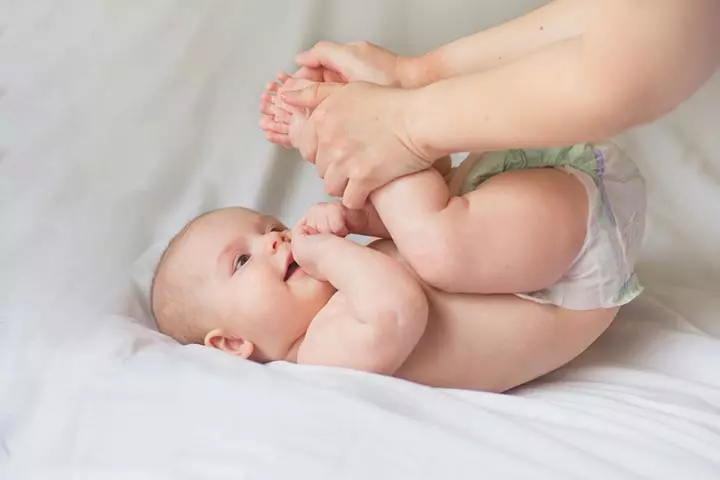
This exercise is aimed at strengthening your baby’s core and leg muscles. Lay your baby on their back and keep their legs as straight as possible. Gently move their right toe to touch the left ear and the left toe to touch their right ear. Be gentle and move the limbs within their natural range of motion (11). Ensure that you are not forcefully stretching the baby’s limbs.
8. Wheelbarrow fun

It is a fun exercise, and most babies enjoy it. Lay your little one on their tummy and slowly lift the lower half of their body while placing your hand on their back. The idea of this exercise is to get your baby to balance their upper body on their arms and hands. Remember to be gentle and place your baby on a soft surface, such as a rug.
Jill, a mother of three and a pediatric occupational therapist, shares how she used the wheelbarrow to create a fun activity for her children. She says, “I did this with my three children when they were very young while we prepared for a bath. Each had a turn going down the hall and back. They loved it, and because we tacked it onto a task done every day, we never forgot to enjoy our “wheelbarrow workout (ii)”. She recommends starting with very short distances and allowing rest periods. As the child gets stronger, the time and distance gradually increase for more fun and fitness.
9. Assistive baby crunches

It is similar to the crunches adults do, but you do all the hard work for your baby. Lay your baby down on their back, grab their arms, and gently pull them up into a sitting posture. Make sure your baby’s back is upright. Gently lay them down again. Repeat this a few times each day. Pull only with the help of baby’s effort, don’t pull when the baby’s arms are fully extended and against baby’s will.
 Quick tip
Quick tipHow To Exercise With Your Baby?
Exercising with your baby is a great way to stay active while bonding. There are many exercises that can benefit you and your baby. You can try them based on your convenience and your baby’s age. Here are some fun ways to exercise with your baby (4).
- Floor exercises: Perform gentle stretches, yoga, or bodyweight exercises while your baby enjoys tummy time or plays nearby. Babies will enjoy lifting exercises such as standing overhead or bench presses (14).
- Water workouts: Join aqua aerobics or baby swim classes for a low-impact, effective workout. Swimming also helps with your baby’s motor development.
- Mom & baby workout groups: Sign up for family-friendly fitness classes or mom-and-baby playdates to stay active and meet other parents.
- Walking, jogging, or running: Use a jogging stroller to take your baby on walks or runs, ensuring proper head and neck support.
- Cycling: Ride a bike with a secure baby seat or trailer designed for infants, following all safety guidelines.
 Point to consider
Point to considerPrecautions To Ensure Your Baby’s Safety During Exercise
Ensuring your baby’s safety during exercise is as essential as the activity. Taking the proper precautions helps promote healthy movement while preventing strain or injury. Keep these key safety tips in mind:
- Arrange for a soft surface like a play mat or carpet away from hard furniture and toys. It keeps your baby safe while moving around.
- Move your baby’s body slowly and gently. Being gentle helps their muscles and joints grow properly.
- Try just one new exercise at a time. It lets your baby get used to each movement before learning another one.
- Start with short 5-10 minute sessions. You can make them longer as your baby enjoys them more. The best time to exercise is when your baby is awake and happy, about an hour after eating.
- Keep a close watch over your baby. If they cry, look upset, or seem tired, stop and let them rest.
Before starting any exercises with your baby, consult their doctor, especially if your baby was born prematurely or has health concerns. Your doctor can guide you on which exercises are safe for your little one.
Frequently Asked Questions
1. Can babies exercise while sleeping?
It is normal for babies to roll over, crawl, or flip over when they are asleep. However, the onset of crawling can cause significant changes in sleep patterns as motor skills are often processed during the REM sleep phase (16).
2. Is it okay for a baby to sleep after exercise?
Babies tend to feel tired after physical activity. However, it’s usually not a cause for concern if the baby falls asleep after exercising.
3. What is the best time to exercise for a baby, day or night?
Activity levels differ from infant to infant. Incorporate it into your daily schedule at a convenient time for both you and the baby.
These exercises for babies will help in their overall physical development and also aid in strengthening their muscles. But you should remember that you need to choose the exercise based on your baby’s age and it is best advised to consult a pediatrician before doing so. After that, you can start doing these exercises with your baby and also have a good bonding time while doing so. You must encourage your baby to perform physical activities such as reaching out and grabbing things and include tummy time in their daily routine.
Infographic: Exercise Guidelines For Babies
Exercise is vital for the physical and mental development of babies. However, it’s important to follow certain guidelines to ensure your child stays safe and healthy while participating in physical activity. Hence the infographic listed some general exercise guidelines for babies and tips for incorporating physical activity into their routine.
Some thing wrong with infographic shortcode. please verify shortcode syntax
Illustration: Easy Exercises For Babies At Different Ages

Image: Stable Diffusion/MomJunction Design Team
Personal Experience: Sources
MomJunction articles include first-hand experiences to provide you with better insights through real-life narratives. Here are the sources of personal accounts referenced in this article.
i. Best ways to burp a baby to help with colic, reflux and gas: These will work!;
https://youtu.be/Wg_wBw1fbzI?feature=shared
ii. Wheelbarrow Walking;
https://themotorstory.org/2014/01/30/wheelbarrow-walking/
References
- Natalie Eichner-Seitz et.al; (2025); Physical activity in infancy and early childhood: a narrative review of interventions for prevention of obesity and associated health outcomes.
https://pmc.ncbi.nlm.nih.gov/articles/PMC10244791/ - Physical activity and exercise for children.
https://www.pregnancybirthbaby.org.au/physical-activity-and-exercise-for-children - Making Physical Activity a Way of Life: AAP Policy Explained.
https://www.healthychildren.org/English/healthy-living/fitness/Pages/Making-Fitness-a-Way-of-Life.aspx - Exercise with Your Baby.
https://www.eatright.org/fitness/physical-activity/workout-ideas/exercise-with-your-baby - For infants toddlers and preschoolers (birth to 5 years).
https://www.health.gov.au/topics/physical-activity-and-exercise/physical-activity-and-exercise-guidelines-for-all-australians/for-infants-toddlers-and-preschoolers-birth-to-5-years - Guidelines On Physical Activity Sedentary Behaviour And Sleep For Children Under 5 Years Of Age.
https://iris.who.int/bitstream/handle/10665/311664/9789241550536-eng.pdf? - Promoting Physical Activity for Infants and Toddlers in Early Childhood Settings.
https://www.adph.org/healthystart/assets/physicalactivitypresentation.pdf - Palmar Grasp Reflex(Archived).
https://www.ncbi.nlm.nih.gov/books/NBK553133/ - Reach Grasp and Release Activities.
https://www.nhsggc.org.uk/kids/resources/ot-activityinformation-sheets/reach-grasp-and-release-activities/ - Tummy Time for a Healthy Baby.
https://safetosleep.nichd.nih.gov/reduce-risk/tummy-time - 7 Fun Exercises for Babies 0-12 Months!
https://www.shardahospital.org/blog/fun-exercises-babies-0-12-months/ - Babies and swimming.
https://www.pregnancybirthbaby.org.au/babies-and-swimming - Encourage Your Baby or Toddler to Squat With These 5 Exercises.
https://napacenter.org/squats-for-kids/ - 10 exercises you can do with your new baby.
https://utswmed.org/medblog/exercise-after-pregnancy-with-baby/ - 7 Therapy Exercises to Try at Home with a Peanut Ball.
https://napacenter.org/peanut-ball-exercises/ - Anat Scher and Dina Cohen; (2015); Sleep As A Mirror Of Developmental Transitions In Infancy: The Case Of Crawling.
https://srcd.onlinelibrary.wiley.com/doi/abs/10.1111/mono.12145
Community Experiences
Join the conversation and become a part of our nurturing community! Share your stories, experiences, and insights to connect with fellow parents.
Read full bio of Dr. Rana Chanchal
Read full bio of Dr. Meenakshi Maruwada
Read full bio of Rohit Garoo
Read full bio of Ghazia Shah









